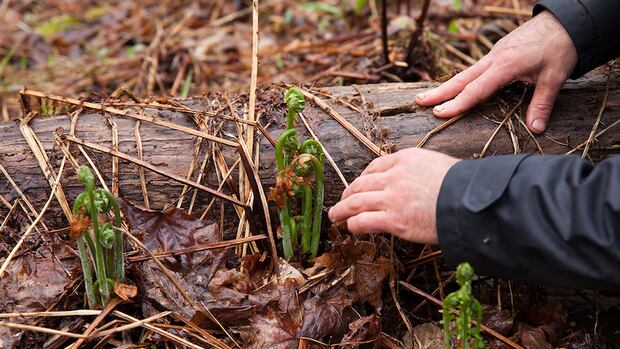Tips for foragers looking for edibles in B.C. forests right now
Chef and expert forager Bill Jones on what to pick and how to stay safe doing it

The B.C. woods can be a veritable buffet of edible roots and shoots in the spring and summer and, if you know what to look for, you can add highly-nutritious foods to your diet at zero cost.
Bill Jones, a chef, author and mycologist based in the Cowichan Valley, says there are already a few snackable treats starting to be ripe for the picking now, with others coming up soon, and he suggests doing some grocery shopping in the great outdoors — as long as you stay safe while doing so.
"Dusk and dawn...they're not good times to be in the forest," said Jones, speaking Monday on CBC's The Early Edition.
The practised forager says these are the times of day when people are most likely to have a run-in with a cougar and there are plenty of these predator cats on the West Coast.
According to the B.C. Environment Ministry, the best tactic is to make yourself appear as large as possible and back away slowly, making sure the animal has a clear avenue of escape.

More tips on how to handle a cougar encounter can be found here.
Jones also stressed the importance of knowing the land you are picking on so you can be certain the soil is not full of pollutants or contaminants.
There is also zero harvesting allowed in B.C.'s provincial parks.
But what can I pick?
In early spring, Jones suggests looking for stinging nettle, which has a minty, spinach-like quality and grows in abundance in B.C.
The little hairs on the stem will give you a rash, much like poison ivy, so it is important to cover your skin up when harvesting the plant.

If you pick the plant when it's young, you can eat the root, which is high in iron and minerals. The leaves can also be boiled into tea.
Jones recommends harvesting a lot, boiling up the plants, squeezing out the excess water and freezing the greens to use year round.
Other edibles to keep an eye out for right now, says Jones, are dandelions and morel mushrooms.
Dandelions, which Jones says are actually invasive and were likely brought to Canada by French settlers who grew herb gardens, have many uses.
The roots can be boiled and ground as a coffee substitute, the greens and roots can be boiled into a tea, and Jones suggests stir frying dandelion flower buds with garlic as a healthy addition to a meal.
"Bitter greens are very good for your digestion," said Jones.

And you can also look for morel mushrooms in about May in B.C., something Jones is looking forward to and says may be delayed a little this year as the winter was a bit cold.
"They are high on my hit list," he said about the elusive mushrooms that are loved for their nutty, earthy flavour.
All the green tips that come out on the conifers, like fir tips, spruce tips and pine tips, are also available to pick and eat in the province when the weather warms.
Fiddlehead greens, the furled fronds of a young fern, are usually ready for picking in early spring, often in April.
And B.C. berries will start with salmon berries as the opening act in late spring, followed by the all-star line up of thimble berries, huckleberries and blackberries as summer unfolds.
Be careful never to eat anything you can't identify with 100 per cent certainty and remember never to forage alone or rely on a cellphone for navigation or rescue.
LISTEN | Forager and chef Bill Jones on what grows wild and edible in B.C.:
With files from The Early Edition, Courtney Markewich
